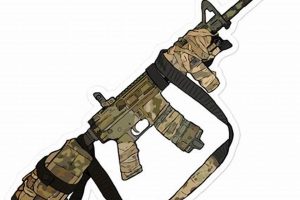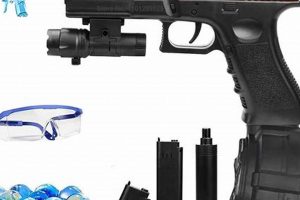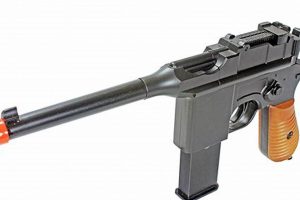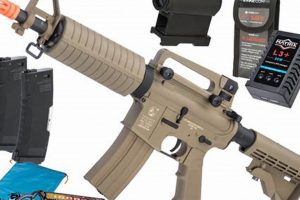Airsoft replicas utilizing an electric motor to power a piston-driven air compression system constitute a significant category within airsoft weaponry. These models generally employ a rechargeable battery pack to cycle the internal mechanisms responsible for propelling projectiles. A standard example includes a rifle designed to resemble a real-world firearm, but modified internally to use battery power for simulated automatic or semi-automatic firing.
The prevalence of this type of airsoft device stems from its combination of reliability, ease of use, and versatility. Historical development reflects a shift towards enhanced performance and battery technology, increasing both rate of fire and sustained operational capability. The utilization of this class of weaponry in training scenarios and recreational skirmishes emphasizes its role in providing a relatively safe platform for simulated combat.
The subsequent sections will delve into the operational principles governing these devices, explore the different types available, and examine the considerations involved in their maintenance and modification.
Operational and Maintenance Guidance for Electric Airsoft Devices
The following guidelines are presented to ensure optimal functionality, longevity, and safe operation of airsoft weaponry powered by electric mechanisms.
Tip 1: Battery Selection is Crucial: Employ battery packs specifically designed for electric airsoft guns. Verify voltage and discharge rate compatibility with the gearbox and motor specifications. Mismatched batteries can cause motor burnout or gearbox failure.
Tip 2: Gearbox Maintenance: Regularly inspect the gearbox for wear and tear. Re-lubricate internal gears with appropriate grease to minimize friction and prevent premature failure of mechanical components.
Tip 3: Motor Care: Monitor motor temperature during sustained firing. Overheating indicates excessive stress or a potential mechanical issue. Allow the motor to cool down periodically to prevent demagnetization or winding damage.
Tip 4: Hop-Up Unit Adjustment: Properly adjust the hop-up unit to optimize projectile trajectory. Incorrect settings can lead to reduced range and accuracy. Understand the relationship between hop-up pressure and projectile weight for best results.
Tip 5: Cleaning and Storage: Clean the barrel regularly to remove debris and improve accuracy. Store the device in a cool, dry place with the battery disconnected to prevent discharge or corrosion.
Tip 6: Fuse Inspection: Check the fuse regularly. A blown fuse indicates an electrical overload, which should be investigated and resolved before replacing the fuse. Using a higher-amperage fuse can damage the internal circuitry.
Tip 7: Wiring Examination: Inspect the wiring for frayed insulation or loose connections. Damaged wiring can cause short circuits or intermittent performance issues. Replace damaged wires promptly.
Adherence to these maintenance protocols maximizes operational effectiveness and mitigates the risk of mechanical malfunctions in airsoft equipment of this type.
Subsequent discussions will explore specific models and advanced customization options.
1. Battery Powered
The operational core of electric airsoft devices hinges directly on the utilization of battery power. The battery serves as the primary energy source, providing the necessary electrical current to activate the internal motor. This motor, in turn, drives the gearbox mechanism, responsible for compressing air and propelling projectiles. Without a functional and compatible battery, the airsoft replica remains inoperable, as the mechanical components lack the required energy input to function. As a practical example, a standard airsoft rifle cannot be used without its battery being connected and charged.
Battery characteristics, such as voltage, capacity (mAh), and discharge rate (C-rating), significantly influence performance. Higher voltage batteries can increase the motor’s rotational speed, resulting in a higher rate of fire. Greater capacity allows for longer operational durations between charges. Insufficient discharge rates can lead to motor strain and diminished performance. Therefore, selecting a battery with appropriate specifications for a given electric airsoft device is crucial for optimal function and longevity. In terms of battery compatibility, the industry has developed adaptors and MOSFET units to aid in providing power to various types of electric airsoft guns, ensuring maximum performance and mitigating potential failure to function.
In summary, the battery forms an indispensable element within the architecture of electric airsoft guns. Its proper selection, maintenance, and operation are paramount to ensuring reliable performance and avoiding potential mechanical or electrical failures. Understanding the relationship between battery specifications and operational characteristics provides a foundational understanding for maximizing the effectiveness of these devices. The practical significance of this understanding ensures users have their guns functioning correctly and for extended periods during the game.
2. Gearbox Mechanism
The gearbox constitutes a critical subassembly within electrically powered airsoft weaponry, performing the essential function of converting rotary motion from the electric motor into linear motion to drive the piston and compress air.
- Components and Configuration
The gearbox typically comprises a series of meshing gears, a piston assembly, and a cylinder. The electric motor rotates a pinion gear, which then drives a series of spur gears or bevel gears to increase torque and reduce speed. This torque is then used to pull back the piston within the cylinder, compressing air. The specific arrangement and ratio of these gears directly influence the firing rate and the power of the airsoft replica.
- Piston and Cylinder Functionality
The piston, fitted with an O-ring to ensure a tight seal, moves within the cylinder. As the piston is pulled back by the gear system, it compresses air. When the piston reaches its rearward limit, it is released, and the compressed air is forced through the nozzle and propels the projectile. The volume of the cylinder and the seal between the piston and cylinder are crucial for consistent performance. For example, a damaged O-ring can cause air leaks, reducing the power and range.
- Trigger Mechanism and Electrical Circuitry
The trigger mechanism controls the electrical circuit that activates the electric motor. When the trigger is pulled, it completes the circuit, allowing current to flow to the motor and initiate the firing cycle. A cutoff lever interrupts the circuit after each cycle in semi-automatic mode or allows continuous cycling in full-automatic mode. Proper function of the trigger mechanism and the electrical circuitry is vital for reliable operation.
- Material and Durability Considerations
Gearboxes are typically constructed from metal or reinforced polymer. Metal gearboxes offer increased durability and are better suited for high-power applications. Polymer gearboxes are lighter and less expensive but may be more prone to wear or failure under stress. The quality of the materials used in the gearbox directly affects the lifespan and reliability of the airsoft weapon. High-grade steel gears, for example, can withstand greater stress and heat compared to lower-quality metal gears.
These facets illustrate the integral role of the gearbox within the broader framework of electrically powered airsoft devices. Optimizing gearbox components and maintenance directly impacts overall performance and longevity. Considerations regarding material selection, gear ratios, and electrical integrity are essential for both manufacturers and users seeking to maximize the effectiveness of airsoft replicas.
3. Adjustable Hop-Up
The adjustable hop-up unit constitutes an integral component of most electric airsoft weaponry, significantly influencing projectile trajectory and range. This mechanism imparts backspin to the projectile as it exits the barrel. This backspin generates lift, counteracting the effects of gravity and extending the effective range. The adjustment capability allows users to fine-tune the amount of backspin applied, optimizing it for different projectile weights and desired ranges. For instance, a heavier projectile typically requires more backspin than a lighter one to achieve optimal flight characteristics.
The presence and proper adjustment of the hop-up unit directly affect the accuracy and engagement distance of the airsoft device. Without hop-up, projectiles exhibit a steep downward trajectory, limiting range and making accurate targeting difficult. Conversely, excessive hop-up can cause projectiles to curve upwards excessively, leading to inaccurate shots. Therefore, understanding the principles of hop-up and how to properly adjust it is crucial for maximizing the performance of electric airsoft weapons. As an example, in a scenario requiring engagement at a distance of 150 feet, a properly adjusted hop-up can be the difference between a successful hit and a miss. This adjustment also aids in different environmental conditions, to achieve maximum accuracy.
The adjustable hop-up mechanism represents a critical element in electric airsoft guns, substantially enhancing their operational effectiveness by extending range and improving accuracy. Its adjustability accommodates diverse projectile weights and environmental conditions. Proper configuration of the hop-up mechanism is essential for achieving optimal performance. While there are aftermarket and DIY parts out there, having the gun professionally looked at by certified individuals could potentially lead to a much better experience for the user.
4. Rate of Fire
Rate of Fire (ROF) constitutes a primary performance metric for electric airsoft guns, quantifying the number of projectiles discharged per unit of time, typically rounds per minute (RPM). The ROF significantly influences the tactical application and competitive viability of an airsoft replica.
- Factors Influencing ROF
Multiple factors contribute to the ROF of an electric airsoft gun. These include the motor’s rotational speed, the gear ratio within the gearbox, the battery voltage, and the electrical system’s efficiency. High-speed motors, lower gear ratios, and higher voltage batteries generally result in increased ROF. However, exceeding the design limitations of these components can lead to premature wear or mechanical failure.
- Gear Ratio and Motor Selection
The gear ratio in the gearbox directly dictates the relationship between motor speed and piston cycling speed. Lower gear ratios (e.g., 13:1) prioritize ROF, enabling faster piston movement at the expense of torque. Higher gear ratios (e.g., 18:1) prioritize torque, resulting in a slower ROF but increased pulling power for heavier springs or pistons. Motor selection must align with the chosen gear ratio. High-torque motors complement higher gear ratios, while high-speed motors pair well with lower gear ratios.
- Battery Voltage and Discharge Rate
Battery voltage provides the electrical potential that drives the motor. Higher voltage batteries generally result in higher motor RPM and consequently, a higher ROF. The battery’s discharge rate (C-rating) dictates its ability to deliver sustained current. Insufficient discharge rates can bottleneck performance, preventing the motor from reaching its full potential ROF. For example, using an 11.1V LiPo battery with a high C-rating on a compatible AEG can significantly increase the ROF compared to a 7.4V battery.
- Practical Implications of ROF
The ROF directly influences tactical effectiveness in airsoft skirmishes. Higher ROF allows for increased suppressive fire, potentially overwhelming opponents or controlling engagement zones. However, it also results in faster ammunition consumption and can make accurate shot placement more challenging, especially at longer ranges. Balancing ROF with accuracy and ammunition management is crucial for optimal performance.
In conclusion, the ROF is a critical performance characteristic of electric airsoft guns, governed by a complex interplay of electrical and mechanical factors. Optimization of ROF necessitates careful consideration of motor selection, gear ratio, battery specifications, and tactical considerations. Understanding these relationships enables informed decision-making when selecting or modifying an airsoft replica for specific applications.
5. Internal Components
The performance and longevity of electrically powered airsoft replicas are intrinsically linked to the quality and configuration of their internal components. These components, working in concert, dictate the overall functionality, reliability, and potential for modification of the device.
- Motor Assembly
The electric motor serves as the prime mover, converting electrical energy into mechanical rotation. Motor selection impacts rate of fire, trigger response, and overall power output. Higher-torque motors facilitate the use of heavier springs, while high-speed motors prioritize rapid firing. The type of armature, winding configuration, and magnet strength contribute to the motor’s performance characteristics. For example, a neodymium magnet motor generally offers superior performance compared to a ferrite magnet motor.
- Gear Set
The gear set transmits rotational force from the motor to the piston assembly. Gear ratios influence the relationship between motor speed and piston velocity, directly impacting rate of fire and power. Steel gears provide greater durability compared to brass or aluminum gears, particularly in high-stress applications. The precision of gear manufacturing minimizes friction and maximizes efficiency. A properly shimmed gear set reduces noise and extends component lifespan.
- Piston and Cylinder Assembly
The piston and cylinder assembly is responsible for compressing air to propel the projectile. Piston material, O-ring seal integrity, and cylinder volume influence air compression efficiency and consistency. Upgraded pistons with reinforced teeth enhance durability, while ported cylinders can fine-tune air volume for optimal performance with specific barrel lengths. A damaged or poorly sealed piston can lead to significant power loss and inconsistent shot-to-shot performance.
- Hop-Up Unit and Bucking
While previously mentioned separately, the Hop-Up unit can be looked at as an internal part in the overall function. The hop-up unit imparts backspin to the projectile, extending range and improving accuracy. The hop-up bucking, a rubber component within the unit, makes direct contact with the projectile and influences the amount of backspin applied. Bucking material and design affect grip, consistency, and durability. A well-matched hop-up unit and bucking are essential for achieving optimal range and accuracy.
These internal components collectively determine the operational capabilities of electric airsoft devices. Component selection, maintenance, and modification directly impact performance and reliability. Understanding the interplay between these elements is crucial for users seeking to optimize their airsoft replicas for specific purposes.
Frequently Asked Questions Regarding Electric Airsoft Guns
The following addresses common inquiries and misconceptions surrounding electrically powered airsoft replicas, providing clarity on their operational characteristics and usage.
Question 1: What is the typical operational lifespan of the internal battery?
Battery lifespan is contingent upon capacity (mAh), discharge rate (C-rating), and usage patterns. A higher capacity battery, judiciously managed, will provide extended operational time compared to a lower capacity counterpart. Discharge rate must be compatible with the airsoft device’s electrical system to prevent premature degradation. Regular charging and adherence to manufacturer guidelines are essential for maximizing battery longevity.
Question 2: How frequently should the gearbox be serviced?
Gearbox service intervals depend on usage intensity and environmental conditions. For recreational use, annual servicing may suffice. High-intensity usage, such as in competitive scenarios, necessitates more frequent servicing, potentially every 3-6 months. Regular lubrication and inspection for wear are critical preventive measures.
Question 3: What are the common causes of motor failure in electric airsoft guns?
Motor failure commonly stems from overheating, excessive stress, or electrical overloads. Overheating can result from prolonged firing or incompatible battery configurations. Stress may arise from using excessively powerful springs. Electrical overloads can occur due to short circuits or faulty wiring. Addressing these underlying causes is crucial for preventing recurrence.
Question 4: Is it possible to modify the rate of fire, and what are the potential consequences?
Rate of fire modification is possible through various methods, including motor upgrades, gear ratio adjustments, and battery voltage changes. However, such modifications can induce increased stress on internal components, potentially leading to premature wear or failure. Prudent modification requires careful consideration of component compatibility and operational limitations.
Question 5: What safety precautions should be observed when handling electric airsoft guns?
Strict adherence to safety protocols is paramount. Eye protection is mandatory at all times. Airsoft devices should be treated as firearms, with muzzle awareness and responsible handling practices. Transport should occur in designated cases or bags, and storage should be in a secure location inaccessible to unauthorized individuals. Negligence can result in severe injury or property damage.
Question 6: What is the legal status of owning and operating electric airsoft guns?
Legal regulations pertaining to airsoft devices vary by jurisdiction. Familiarization with local laws and ordinances is essential. Age restrictions, permissible usage locations, and transportation requirements may apply. Non-compliance can result in legal penalties or confiscation of the airsoft device.
Understanding the operational characteristics, maintenance requirements, and safety protocols associated with electric airsoft replicas is crucial for responsible and effective utilization.
The following will address troubleshooting common issues and when to seek professional assistance.
Conclusion
This exposition has elucidated the core components, operational principles, and maintenance requirements associated with electric airsoft guns. From the foundational role of battery power to the intricacies of gearbox mechanisms and hop-up adjustments, a comprehensive understanding of these facets is essential for both recreational users and serious enthusiasts. The interplay of these elements dictates performance characteristics such as rate of fire and accuracy, directly impacting the user experience.
As technology continues to evolve, further advancements in battery technology, motor efficiency, and material science are anticipated to enhance the capabilities of these devices. Continued adherence to safety protocols and responsible usage practices remains paramount. Ongoing engagement with educational resources and adherence to best practices will contribute to a safer and more rewarding experience within the airsoft community.







